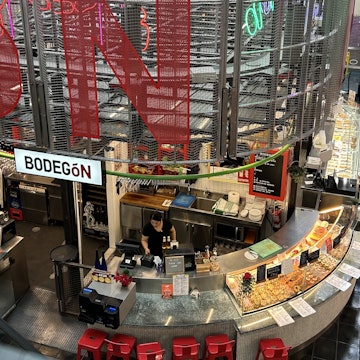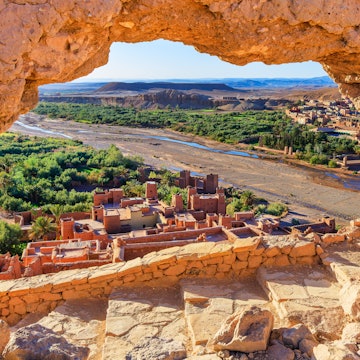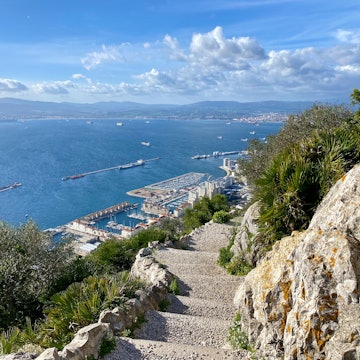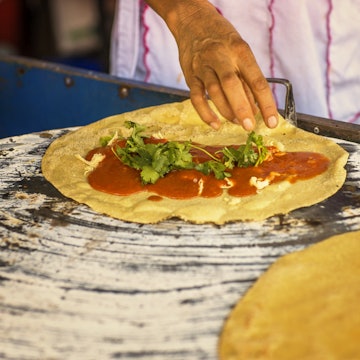
Spanish agritourism: Rural experiences in La Rioja and beyond
Sponsored by

Jul 12, 2024 • 8 min read

Sustainable agritourism activities – like you can find at Quesos Artisanos Villarejo – are revered cultural experiences in Spain. Blake Horn for Lonely Planet
Spain’s gorgeous capitals are must-see stops on any European tour. But the authentic heart of the country beats on the outskirts, in Spain’s rural plains and villages.
It beats in the dehesas – bucolic pastures where cork and holm oaks dot the landscape, providing a sustainable source of income from the regular harvesting of cork. It’s under these trees, feasting on the acorns of the oaks, that Spain’s famous black Iberian pigs graze. The resulting rich, nutty flavor makes Spain’s ham one of the world’s most celebrated foods.
It also beats in the country’s casa rurales (country houses). These family farms offer a glimpse into the authentic rural lifestyle, allowing guests to participate in farming activities, taste local produce, and engage with the warm hospitality of the local communities.
Casas rurales are popular among tourists seeking a more immersive and tranquil vacation experience. Blake Horn for Lonely Planet
Las Lucias is one such casa rural. Owned by Jose ‘Pepe’ Tasso and his wife, Gema Pérez-Zubizarreta Cuadrado, this typical farm is home to sheep, goats, chickens and turkeys, which roam freely over the grounds. Among other activities, visitors can help collect eggs, learn to milk goats, and then make cheese from the goat’s milk. It’s a hands-on experience that not only highlights Spain’s traditions but also connects visitors with the land and its people.
These types of sustainable agritourism are revered cultural experiences in Spain. Here are some more of our favorites:
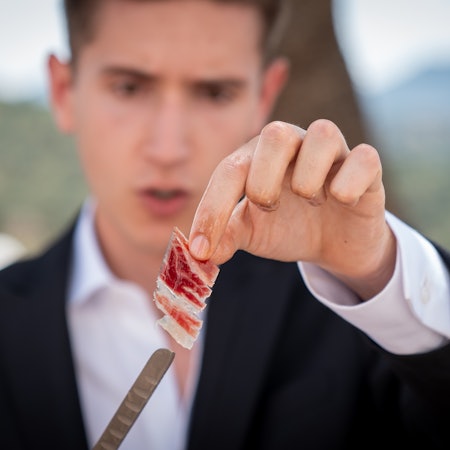

Ibérico ham
Spain’s ham is often aged in the warm breeze of Extremadura. Head to a dehesa to see how the free-ranging Ibérico pigs become these priceless legs of cured ham. At the main house, you might get a tasting from a ham cutter, who will show you how he carves up jamon iberico into small, thin slices.
@lonelyplanet Three words: award 🤤winning 🤤 ham 🤤 Come dig into jamón ibérico in Spanish culture and cuisine with us. @visitSpain
♬ original sound - Lonely Planet
Citrus
With more than 300 days of sun a year, Valencia is not only an ideal destination for travel, it’s the orange basket of Spain. The sweet, juicy oranges are a staple in Spanish households, and you can visit explore a well-preserved orchard right outside of town, see the wide variety of oranges produced, and even pluck some off the tree yourself for a tasting.

Cider
Green Spain specializes in jaw-dropping beauty and rich history, and the same goes for its popular cider culture. The beloved Asturian version is light and sour, and the only thing better than downing some to wash down a delicious steak is visiting a local family-run llagar to see how it is made.
Almadraba tuna
Andalucía is renowned for its red tuna, caught using an ancient and sustainable fishing method called the almadraba. Dating back to the time of the Phoenicians, this technique is unique in the world and, during tuna season, you can hop on the boat to see it firsthand.

Cheese
Manchego cheese, hailing from Castilla-La Mancha, is a beloved sheep's milk cheese known for its distinctive flavor and criss-cross-patterned rind. The rolling hills of Basque Country and Navarre are also a beautiful backdrop for traditional cheesemaking, and produce some of Spain’s most well-known DO cheeses, Idiazábal and Roncal. Pair a visit to the Idiazabal Cheese Museum with a pop-in to a nearby farm, where you can see the Latxa sheep responsible for this delicious, often smoky cheese.
Saffron
Castilla-La Mancha is famous for producing some of the world's finest saffron, known for its deep color and intense aroma. To gather one gram of this ‘red gold,’ 150 delicate crocus flowers must be collected, and if you visit in October and November, you can experience the harvest for yourself.
@lonelyplanet Curious about agritourism? It’s Extremadura’s thing, and these locals have the scoop. Find your own “magical moment,” as Pepe says, whether that’s by making your own cheese or staying in a country house on a farm – one of Raul’s recs for your next Spanish adventure! #spain #spaintravel @visitSpain
♬ original sound - Lonely Planet

Four days in La Rioja – the epitome of Spanish agritourism
No place better shows the agricultural side of Spain than La Rioja, a region of ochre earth and vast blue skies, which produces some of the country's best red wines. La Rioja radiates outward from the Ebro River, bounded for more than 100 miles by rolling vineyards and dusty medieval villages on either side, a genuine agritourism treasure trove of local producers, farm stays, wineries, and festivals.
Editor’s note: It should go without saying, but always enjoy winery experiences responsibly and have a designated driver. Never drive after drinking.


Where to stay
There is no shortage of charming lodging sprinkled throughout the vineyards of La Rioja. Be strategic and choose based on the wineries and activities on the day’s docket.
In Rioja Baja, try the wonderfully rustic Posada de Urreci, homey and located right outside the medieval village of Aldeanueva de Cameros.
For a more luxe agritourism vibe, try Finca de los Arandinos, a concrete and wood-clad modern wonder with an onsite winery, just a stone’s throw from the border of Navarre and the Camino de Santiago and designed by fashion-world creative David Delfín and architect Javier Arizcuren. Alternatively, the Marqués de Riscal Vineyard Hotel – designed by Frank Gehry in the style of his Guggenheim Museum Bilbao – looks as if a giant spilled a box of ribbons. Its airy rooms and restaurant look out over vineyards established in 1858.
If you’re rolling deep with family, try Natura Resorts for a summer camp vibe closer to the Rioja Alavesa.
Day 1
Once you’ve settled into your digs, do as the locals do and explore your closest village, which you should now consider your own adopted pueblo. Most Riojan pueblos have a towering church, many of which date back to the 12th century, and never far away from its spires is the village watering hole, a great place to snack, try local red wine, and meet your neighbors. In the summer, if the town seems quiet, check out the municipal pool – that’s where villagers flock on hot summer days.
Start your exploration of the land underneath it by heading to the heart of northern Rioja, Laguardia, a town whose underground is riddled with caves for storing wine. There were once more than 300 underground wineries, from the smallest family caves to larger operations, but today only three remain. One of those is Bodega El Fabulista, whose labyrinthine underground tunnels are packed with both history and the unique Rioja Alavesa wines, light bodied thanks to the carbonic maceration (aka whole grape bunch fermentation method) that is typical of the subregion.


Day 2
Today is all about trying Rioja’s signature smooth, fruity red tempranillo wine. 571 wineries make up the Denominación de Origen of the Rioja, Spain’s official protected designation for wines. Many of these are family-run wineries, who maintain a tight link with generations of traditional viticulture and winemaking. Some offer hands-on experiences for a participatory exploration of the process.
Start at Bodegas Jilabá, where you’ll be welcomed with open arms by the fifth generation of the family for a tour of their vineyards (some of the oldest in the Rioja) before passing through their 500-year-old cellar. A tasting includes not just their wines, but their arbequina olive oil made in-house.
Next, head to Bodegas Ysios, which sits like a pixelated wave against the mountainous backdrop. Designed by Santiago Calatrava, the winery is possibly the most photographed in the entire Rioja, but it’s not just a pretty face. Learn about the small-scale vineyards with a wide diversity of microclimates and soils that provide the raw material for this boutique wine.
Day 3
Grapes aren’t the only thing the region’s abundant lands put forth. Olives thrive in the drier climate, so stroll among the gnarled trees at Almazara Riojana before heading down to the stone-walled olive press to taste the oil, a revelation when freshly pressed. The family-owned business employs some of the same environmentally friendly practices at many of the wineries, relying on natural rainwater for any irrigation and using organic farming practices.
Heading south, the hills begin to roll with more intensity as they build up to the Sierra de Cameros, a higher-altitude area dotted with centuries-old villages and dedicated, in large part, to livestock farming. Much of the region’s milk, used in traditional cheesemaking is sourced from these hills, providing livelihood for the small farmers that call it home. See the cheesemaking process up close at Quesería Roca de Cabra, whose goats you can meet by name before heading to the creamery for a tour and tasting. Or stay closer to Haro and learn the art of traditional olive oil-washed cheese at Quesería Los Cameros, a family-run spot using millennia-old recipes to make their products.

Day 4
No matter where you’re holed up, you’ve likely got one of the Rioja’s hundreds of miles of walking paths outside your front door. Take time to traverse the rich landscape by foot. A good place to start are the former train lines that have been converted to cycling and walking trails (called vías verdes). One of the most picturesque starts in the towns of Casalarreina and Santo Domingo de la Calzada and runs 16 miles to Ezcaray.
Local festivals abound during summer months and harvest season, offering the chance to glimpse local traditions from up close. Don’t get too close, though, if it’s the Haro Wine Festival’s Batalla del Vino. Every June, an early morning hike of white-clad festival goers ends in an all-out wine battle – come in crisp white clothes, leave soaked in purple juice.
While in Haro, sample the bounty of the land at one of its flagship restaurants. Michelin-starred Nublo pays homage to the Rioja’s rivers, its orchards, and ‘an environment full of municipalities made with masonry stone and with an outstanding gastronomic culture.’ It designs its cooking around seasonal and local produce, placing special emphasis on the firewood it uses.


A little more laid-back but no less delicious, is Los Caños. Shareable plates of Rioja cuisine are on offer in this high-ceilinged space and off-menu specials highlight local seasonal ingredients. It’s also one of the best places to sample the local vintages.
Meanwhile, during harvest season, Bodega Lecea puts on the Fiesta del Pisado de la Uva, a grape-crushing romp where attendees live out the romantic (and obsolete) dream of stomping grapes with their bare feet.
Make it Happen
When to visit: From spring to fall is the best time to visit the Rioja, when the vines are leafy and abundant. They begin to turn color by September, a glorious explosion of reds, golds and browns.
How to get in from the airport: The Bilbao airport (BIO) is the closest well-connected airport, located one hour to the North. Vitoria (VIT), 30 minutes away, has a handful of international flights.
Getting around: A car is recommended for moving comfortably between towns and sights. Again, always have a designated driver.
Sponsored by Turespaña
As a travel entertainment and inspirational media outlet, we sometimes incorporate brand sponsors into our efforts. This activity is clearly labeled across our platforms.
This story was crafted collaboratively between Turespaña and Lonely Planet. Both parties provided research and curated content to produce this story. We disclose when information isn’t ours.
With sponsored content, both Lonely Planet and our brand partners have specific responsibilities:
-
Brand partner
Determines the concept, provides briefing, research material, and may provide feedback.
-
Lonely Planet
We provide expertise, firsthand insights, and verify with third-party sources when needed.















